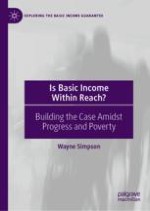2021 | OriginalPaper | Buchkapitel
5. Basic Income in the Twenty-First Century (the 00s and 10s)
verfasst von : Prof. Wayne Simpson
Erschienen in: Is Basic Income Within Reach?
Aktivieren Sie unsere intelligente Suche, um passende Fachinhalte oder Patente zu finden.
Wählen Sie Textabschnitte aus um mit Künstlicher Intelligenz passenden Patente zu finden. powered by
Markieren Sie Textabschnitte, um KI-gestützt weitere passende Inhalte zu finden. powered by
